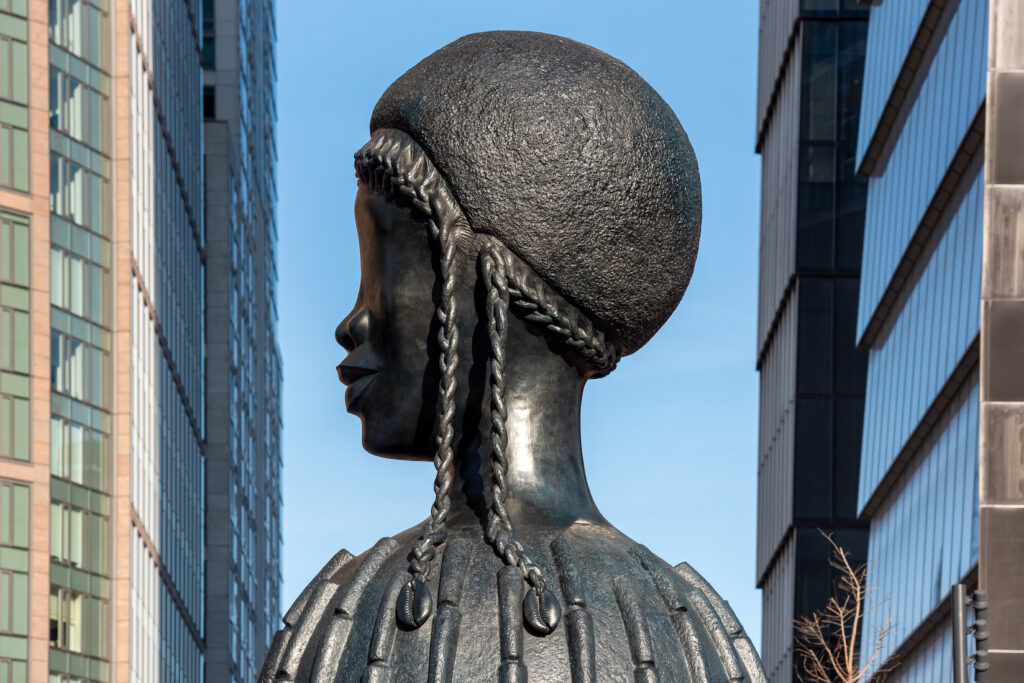
I am excited to hear the news that Simone Leigh will be the first Black woman to represent the United States at the Venice Biennale. I love her sculptures, and first got to know her work while strolling on the High Line. I am a big fan of women supporting women, and love seeing representation continue to grow and expand in every part of the world.
Please see below an article from our friends at the New York Times on Simone Leigh’s exciting new development:
Simone Leigh Is First Black Woman to Represent U.S. at Venice Biennale
The Brooklyn-based sculptor, whose large-scale works explore Black women’s stories and histories, will create the American pavilion’s exhibition for 2022.

Simone Leigh, a Brooklyn-based sculptor whose large-scale works address the social histories and subjective experiences of Black women, will represent the United States at the next Venice Biennale in April 2022. The first African-American woman to receive this honor, among the art world’s most prestigious, Ms. Leigh was selected by theU.S. Department of State’s Bureau of Educational and Cultural Affairson the recommendation of museum professionals and artists convened by the National Endowment for the Arts.
“I feel like I’m a part of a larger group of artists and thinkers who have reached critical mass,” Ms Leigh, 52, said. “And despite the really horrific climate that we’ve reached, it still doesn’t distract me from the fact of how amazing it is to be a Black artist right now.”
The last two U.S. representatives to the Biennale — Martin Puryear, also a sculptor, in 2019, and Mark Bradford, a painter, in 2017 — are Black artists, as well. The next edition was originally scheduled for May 2021, but the pandemic forced it to be postponed a year.
Working primarily in ceramics, Ms. Leigh has long elevated the labor of Black women. She has fused representations of their bodies with vernacular architectural forms from Africa or utilitarian vessels such as jugs and pitchers, made and used throughout the African diaspora.

These distinctive figures, sometimes faceless and veering into abstraction, have been holding court in New York recently, from the 2019 Whitney Biennial to a solo exhibition at the Guggenheim Museum after the artist won the institution’s Hugo Boss Prize in 2018. Ms. Leigh’s majestic 16-foot-tall bronze bust, titled “Brick House,” gazing down Tenth Avenue from the High Line Plinth since 2019, celebrates Black female beauty and strength — not often commemorated in the public sphere. (The Kenyan-American artist Wangechi Mutu recently offered another alternative to monuments in her sculptures of female figures for the facade of the Metropolitan Museum of Art.)
Ms. Leigh’s exhibition at the U.S. Pavilion, a 1930s Palladian-style space with a rotunda and Doric columns, is co-commissioned by Jill Medvedow, director of the Institute of Contemporary Art in Boston, and its chief curator, Eva Respini, who is also organizing the artist’s first survey exhibition at the Boston museum in 2023.
Ms. Medvedow said she could not think of an artist better suited to representing the United States at this time. “The idea of Simone Leigh in Venice does disrupt the narrative of 400-plus years of American history,” she said. “Her sculptures are really commanding in the space they occupy. The scale and presence and magnificence of her figures are so demanding of visibility.”

The neoclassical building sits inside the Giardini, the Venice park that hosts the national pavilions. Ms. Leigh plans to do an outdoor monumental bronze statuary in the forecourt, framed by the building’s architectural colonnade, and a series of sculptures and installations throughout the five interior galleries. “It’s surprisingly similar to working in a space like the White House that just has many layers of meaning,” said Ms. Leigh, who anticipates using ceramic materials, raffia and steel in addition to bronze. “I am aware of those histories as I’m building the exhibition.”
She declined to go into greater detail on what she intends to do, given that the show is a year and a half away and may well change, other than to say it will be anchored by some texts on Black feminist theory, which is how she typically conceptualizes her exhibitions.

The “stiffness” of the U.S. Pavilion can be hard to manage, said Cecilia Alemani, director and chief curator of High Line Art, who commissioned Ms. Leigh’s “Brick House” and is serving as the artistic director of the international group exhibition in the 2022 Venice Biennale.
“On the High Line, Simone confronted the history of sculpture and monumentality,” said Ms. Alemani, noting that the artist chose the traditional technique of bronze figurative sculpture — the same medium as the Confederate statues now being removed from public spaces — to present a symbol of something very different. “It’s a similar relationship with history when it comes to the American pavilion,” she continued. “Her challenge will be to turn that space upside down metaphorically with the stories that she’ll be able to tell through her artwork.”
In a partnership with Spelman College, the historically Black liberal arts college for women in Atlanta, the artist and the curators from the Institute of Contemporary Art will work directly with students on all aspects of the Venice commission as part of a training program for museum professionals and scholars. “It’s one of my favorite parts of the project,” said Ms. Leigh, who has often collaborated with communities of Black feminists in her own performances and video-based works.
“Given the Black female subjectivity of Simone’s topic,” Ms. Medvedow said, the Spelman partnership “felt like a tremendous opportunity and part of this overdue cultural shift about who needs to be represented and how we’re assigning representation in our field.”
